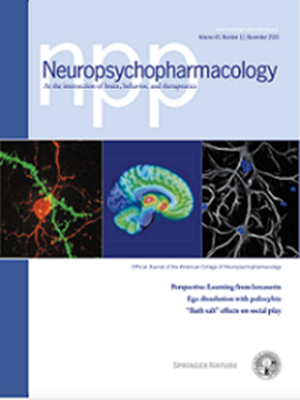The relationship between electric field strength induced by electroconvulsive therapy and cognitive and antidepressant outcomes
IF 6.6
1区 医学
Q1 NEUROSCIENCES
引用次数: 0
Abstract
Electroconvulsive therapy (ECT) is an effective treatment for depression but is often associated with cognitive side effects. In patients, ECT-induced electric field (E-field) strength across brain regions varies significantly due to anatomical differences, which may explain individual differences in cognitive side effects. We examined the relationship between regional E-field strength and change in verbal fluency score (i.e., category fluency animals score from pre- to 1 week post-ECT; as key proxy of cognitive side effects) across different electrode placements in depressed patients. Secondary, we examined the relationship between regional E-field strength and depression outcome. Using T1 magnetic resonance imaging, we performed E-field modeling in a total of 109 patients. Linear mixed models were executed to analyze the relationship between E-field strength across all 118 brain regions and both cognitive and depression outcomes, while correcting for nuisance variables (e.g., age, total number of ECT sessions, and study cohort). We found that a higher E-field strength was significantly associated with a higher decline in verbal fluency (n = 71, false discovery rate [FDR] corrected p < 0.01) in several brain regions in the left hemisphere (e.g., temporal gyrus and operculum cortex). Moreover, numerous significant associations were found only in the 24 patients treated with right unilateral ECT. No significant relationships were found between regional E-field strength and depression outcome. In conclusion, significant associations between verbal fluency and E-field strength were found in areas crucial for linguistic processing and semantic memory. Our findings underscore the importance of considering individualized dosing strategies to optimize cognitive outcome in ECT, while maintaining its antidepressant efficacy.

电惊厥治疗引起的电场强度与认知和抗抑郁结果的关系
电痉挛疗法(ECT)是一种有效的治疗抑郁症的方法,但往往与认知副作用有关。在患者中,由于解剖结构的差异,ect诱导的跨脑区域电场(E-field)强度存在显著差异,这可能解释了认知副作用的个体差异。我们研究了区域电场强度与语言流畅性评分变化之间的关系(即,从ect前到ect后1周,动物的类别流畅性评分;作为认知副作用的关键代理)在抑郁症患者不同的电极放置。其次,我们研究了区域电场强度与抑郁结果之间的关系。采用T1磁共振成像技术,对109例患者进行电磁场建模。采用线性混合模型来分析所有118个大脑区域的电场强度与认知和抑郁结果之间的关系,同时校正干扰变量(如年龄、ECT总次数和研究队列)。我们发现,在左半球的几个大脑区域(如颞回和盖层皮层),较高的电场强度与较高的语言流利度下降显著相关(n = 71,错误发现率[FDR]校正p <; 0.01)。此外,仅在24例接受右侧单侧电痉挛治疗的患者中发现了许多显著的相关性。区域电场强度与抑郁结果之间无显著关系。总之,语言流畅性和电场强度之间的显著关联在语言处理和语义记忆的关键区域被发现。我们的研究结果强调了考虑个体化给药策略的重要性,以优化ECT的认知结果,同时保持其抗抑郁疗效。
本文章由计算机程序翻译,如有差异,请以英文原文为准。
求助全文
约1分钟内获得全文
求助全文
来源期刊

Neuropsychopharmacology
医学-精神病学
CiteScore
15.00
自引率
2.60%
发文量
240
审稿时长
2 months
期刊介绍:
Neuropsychopharmacology is a reputable international scientific journal that serves as the official publication of the American College of Neuropsychopharmacology (ACNP). The journal's primary focus is on research that enhances our knowledge of the brain and behavior, with a particular emphasis on the molecular, cellular, physiological, and psychological aspects of substances that affect the central nervous system (CNS). It also aims to identify new molecular targets for the development of future drugs.
The journal prioritizes original research reports, but it also welcomes mini-reviews and perspectives, which are often solicited by the editorial office. These types of articles provide valuable insights and syntheses of current research trends and future directions in the field of neuroscience and pharmacology.
 求助内容:
求助内容: 应助结果提醒方式:
应助结果提醒方式:


